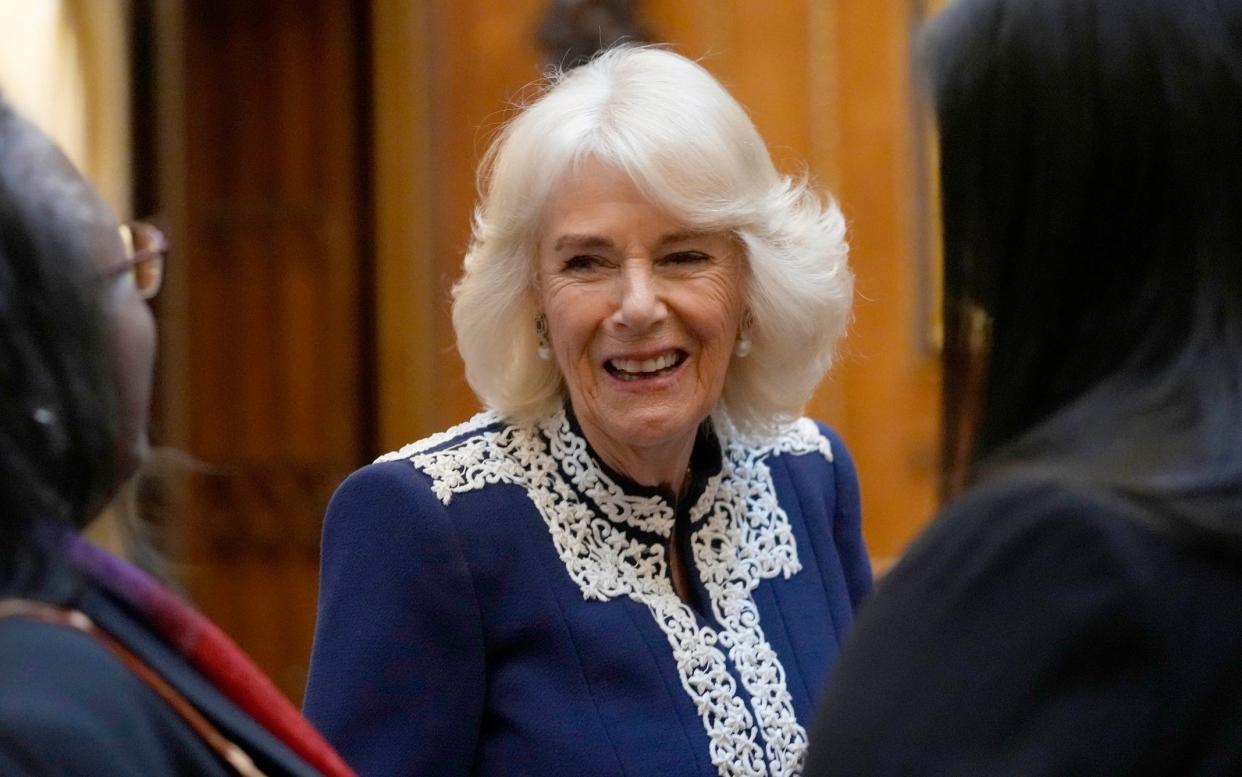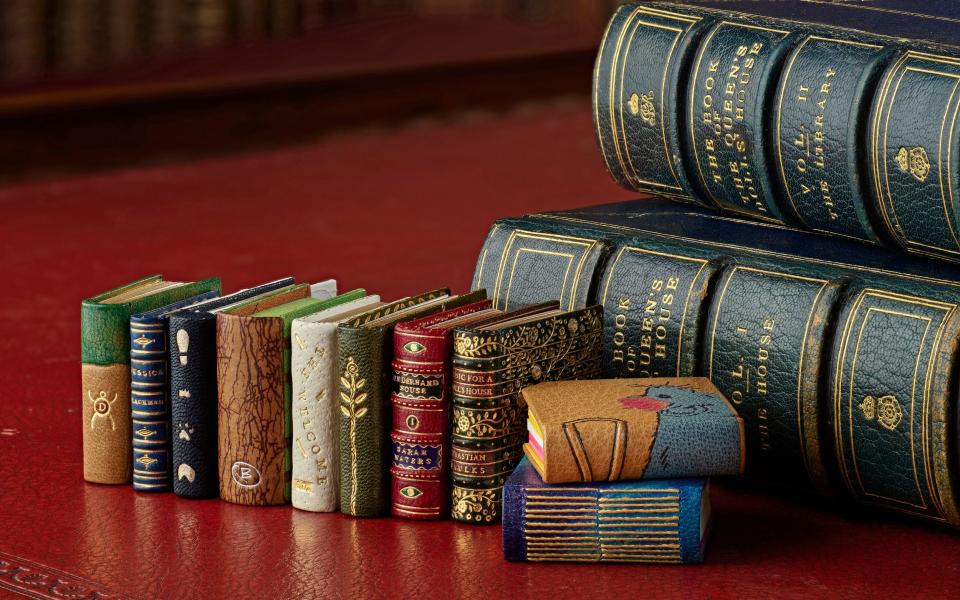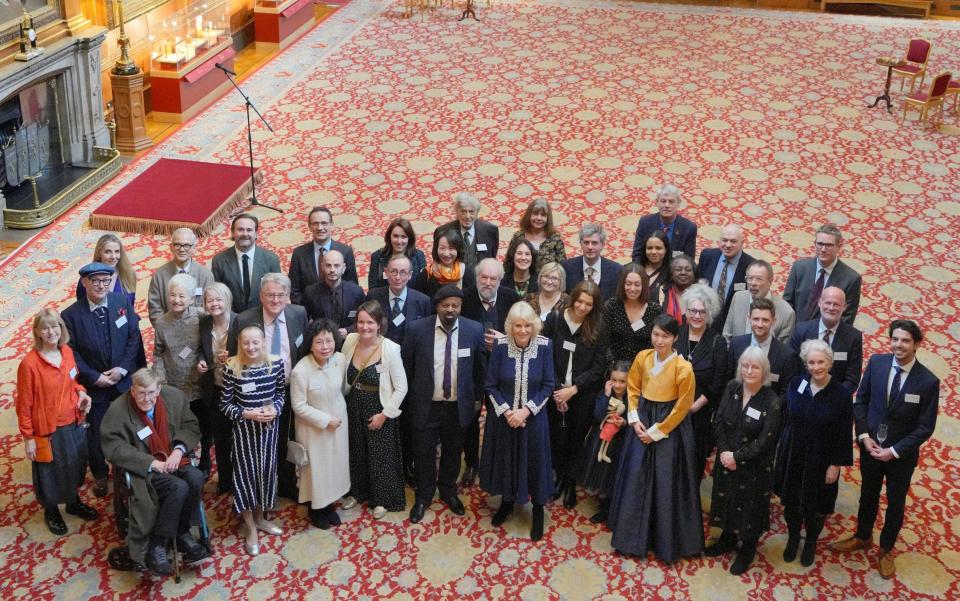Dolls’ house books have taken toll on my eyes, jokes the Queen

- Oops!Something went wrong.Please try again later.
The Queen joked that her eyesight had deteriorated after working on a miniature book that will form part of a new modern library in the world’s largest dolls’ house.
Her Majesty hosted a reception at Windsor Castle for an array of leading authors who have contributed tiny manuscripts to update the collection housed at Queen Mary’s Dolls’ House as it celebrates its centenary.
The Queen, 76, said that as a child, she had always been “fascinated” by the books, handwritten by authors of the 1920s such as Arthur Conan Doyle and Thomas Hardy.
She told those gathered, including Alan Bennett and Julia Donaldson that future generations would marvel at their work just as she had done with the original collection.
Thanking the authors for their hard work, she raised a loud laugh as she said: “I hope your eyesight hasn’t deteriorated that much… Certainly, mine did.”
The Queen said she was “thrilled” with the project, not least the “wonderful binding” that she hailed as “exquisite works of art”.
A voracious reader and patron of a number of literary charities, she wrote an introduction to the project that was bound and presented as her own tiny book.
When the dolls’ house was created in the 1920s, its library was filled with miniature books by contemporary authors deemed to capture the literary culture of the decade.

To mark its 100th anniversary celebrations, the collection was updated to offer a snapshot of modern literature in Britain.
Among those behind the new collection are Sir Tom Stoppard, Sir Ben Okri, Philippa Gregory, Elif Shafak and Malorie Blackman.
The Queen’s son, Tom Parker-Bowles, produced a miniature roast chicken recipe called Fit for a Queen, while the inclusion of Robert Hardman, the biographer, suggests that Charles III, his recent book charting the King’s first year as monarch, had the royal seal of approval.
Hardman wrote 1,200 words over 94 tiny pages measuring just 1.3in by 1.1in about last year’s Coronation, admitting that the task had also taken its toll on his own sight, as he frequently had to stop to give his eyes a break.
In her own offering, The Queen hailed the “incredible richness of 21st-century literary talent”.
As she was presented with her own tiny 16-page book, she said it was “so lovely”.
Glenn Bartley, the head of the royal bindery, described how Her Majesty had used a regular pen nib to write the 254-word foreword to the project.
She was given frames with dimensions to keep the words inside the 1.8in pages to write her message on ordinary cartridge paper before the pages were bound into a book with her cypher.
“For a lot of authors it was quite a challenge,” Mr Bartley said. “The handwriting is extraordinary. The Queen’s was very good and legible.”

The Queen also congratulated the authors on Tuesday for their contributions to “a fantastic scheme”.
She added: “As a child, seeing the dolls’ house for the first time, I was always fascinated by the books.
“The idea of actually seeing these writers, actually seeing their writing, was huge excitement – looking at it and thinking actually that was Conan Doyle and whoever.
“I know the future generation are going to feel the same about all of you. They are going to look at all of these books and say, ‘Goodness, how wonderful to see Alan Bennett and Tom Hardy – see their writing and what wonderful works they’ve done.’”
The Queen said she was “particularly thrilled” to see that so many of the authors had asked their own daughters to illustrate their manuscripts, adding: “It’s really nice to see the mothers and daughters working together.”
She concluded: “I’m thrilled by this and I hope you’ll all be very, very proud of what you’ve done.
“And also the wonderful binders. I’ve never seen such exquisite works of art. It’s not an easy task to do something that small, so congratulations to all of you.”
The Queen hugged Blackman, who wrote A Message to Jessica for the new library collection, kissing her on both cheeks as she said: “Very nice to see you.”
‘Thrilled and excited’
Bennett, the playwright, whose own miniature offering is called The Mantelpiece, told the Queen he was “thrilled and excited” by the project.
Speaking afterwards, he said: “I was flattered to be asked as I don’t regard myself as part of the establishment but it was nice that she remembered me.”
Jacqueline Wilson, who wrote The House Mouse, spoke to the Queen about her story.
She said afterwards: “I loved the dolls’ house when I was a little girl and loved the library so to be asked to take part was extraordinary.
“It was a little challenging to get my handwriting neat enough to be legible. Just took a deep breath and went for it.”
The dolls’ house, a 1:12-scale replica of an Edwardian residence, was built for King George V’s consort as a gift from the nation after the First World War.
More than 1,500 leading artists, craftspeople and manufacturers of the early 20th century, including Rolls-Royce and Cartier, worked on the three-year project to create beautifully furnished rooms, including bedroom suites, a day nursery, a grand saloon boasting red velvet and silver thrones and a sweeping staircase in an impressive marble-style entrance hall.
To mark its 100th anniversary, tiny treasures from the house, including a fully strung grand piano and a sewing machine complete with minuscule thread and scissors, will go on display at Windsor Castle.
There is also a little Hoover vacuum cleaner – a relatively new invention in the 1920s – and a copper kettle made from a coin with the King’s head still visible on its base.
The house itself has been relit to simulate daylight rather than moonlight, and the rooms’ ornate corner niches have been restored and filled with miniature plants and flowers.

